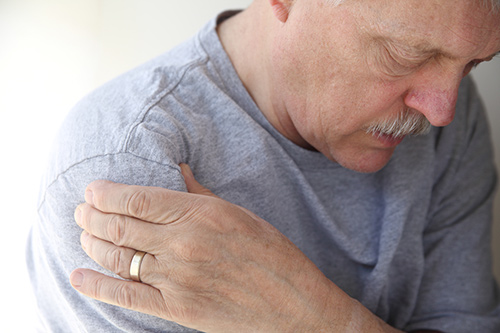
Rotator cuff tears are common and painful. It’s estimated that nearly 2 million people go to the doctor every year because of a rotator cuff problem. With a rotator cuff tear, your shoulder is weakened, making it difficult to perform daily tasks. It’s common to see an increase in shoulder injuries during the summer (e.g., playing more baseball, lifting more moving boxes, doing more construction work). With that in mind, we decided to dedicate a blog to all about rotator cuff tears. Why do they happen, what are the symptoms, and how can they be treated?
What is a Rotator Cuff?
Your shoulder is made up of three bones: the upper arm bone (humerus), shoulder blade (scapula), and your collarbone (clavicle). As a ball and socket joint, the ball of your upper arm fits into the socket of your shoulder blade. This is kept in place by your rotator cuff.
The rotator cuff is made up of four muscles that come together as tendons attached to the humerus. These four tendons create a “cuff” around the top of the arm bone. The four rotator cuff muscles work together to control and stabilize the ball and socket of your joint whenever your arm moves.
Between the bone and rotator cuff is a lubricating sac (bursa), which lets the tendons within the rotator cuff glide smoothly and freely when your arm moves. When one or more of the tendons in the rotator cuff are torn, it’s no longer fully attached to the head of the humerus. In many cases, torn tendons begin by fraying, and as the damage progresses, the tendon can tear completely.
Without a properly functioning rotator cuff, you may be unable to move your arm without severe pain or even at all. The rotator cuff is an essential part of lifting your arm. Without it, you would not be able to rotate your arms outward or inward.
Types of Rotator Cuff Tears
There are different types of tears depending on how the tear happens and the severity of it.
Cause of Tear
- Chronic Tear – With a chronic rotator cuff tear, the tendon is worn down slowly as we age. Repetitive stress caused by performing the same shoulder motion for long periods of time — like throwing a baseball, swinging a tennis racquet, or lifting above your head — can cause stress on your rotator cuff. As we get older, the blood supply to the tendons that make up the rotator cuff lessens, which inhibits the body from efficiently repairing any sustained damage.
- Acute Tear – An acute tear is an injury that occurs suddenly and is associated with trauma. An example of this is falling on your arm or lifting something too heavy. For young and active adults, they’re more likely to have an acute tear.
Severity of Tear
- Partial Tear – A partial tear is an incomplete tear, which means that the tendon has damage, but it’s not entirely severed.
- Full-Thickness Tear – A full-thickness tear is when the cuff is completely torn. The tendon is complete detached from the bone.
Symptoms of Rotator Cuff Tears
As we have said, rotator cuff injuries are painful. Here are the most common symptoms.
- Dull ache deep in the shoulder
- Pain while sleeping, especially if lying on the affected shoulder
- Pain while raising or lowering your arm (or other specific movements)
- Weakness in shoulder and arm
- A cracking sound when moving your shoulder
Not all injuries are the same, so the intensity of pain will vary from patient to patient.
Treatment for a Rotator Cuff Tear
If you are experiencing shoulder pain, you should schedule an appointment with your doctor as soon as possible. Early treatment can prevent your symptoms from getting worse. It will also get you back to your regular routine that much quicker. The goal of any treatment — be it for a chronic or acute injury — is to reduce pain and restore function. There are several treatment options for a rotator cuff tear, and the best option is different for every person. If you have a rotator cuff tear and you keep using it despite the pain, you may cause further damage as it can get worse over time.
For most people with a rotator cuff tear, a conservative form of treatment is recommended. The exception is younger individuals with medium or large tears in their dominant arm or older individuals with severe or debilitating pain. These two groups will likely need surgery to repair their rotator cuffs.
For nonsurgical treatment, your treatment will probably be a combination of things like:
- Getting rest
- Avoiding movements that cause pain
- Taking anti-inflammatory medicine
- Doing physical therapy
- Getting steroid injections, if necessary
Nonsurgical treatment is successful for about 80% of patients within three to six months. If you’re in the remaining 20%, your orthopaedic surgeon may recommend surgery to correct the tear.
Other things that you can do that may relieve pain and improve function are:
- Applying heat and gently massaging your shoulder
- Taking a warm bath or shower for about 15 minutes
- Doing stretches and exercises
Visit Prairie Orthopaedic
Rotator cuff tears can be both painful and frustrating. The orthopaedic surgeons and physical therapists here at Prairie Orthopaedic & Plastic Surgery, PC are highly skilled in the repair and treatment of rotator cuff injuries. If you’re experiencing shoulder pain or are worried that you may have sustained damage to your rotator cuff, please don’t hesitate to give us a call and set up an appointment today at 402-489-4700!
If you have more questions about rotator cuff pathology, watch the Facebook Live video below with our excellent physical therapists, Julie and John.
Source: Rotator Cuff Tears by OrthoInfo; Rotator Cuff Injury by Mayo Clinic

